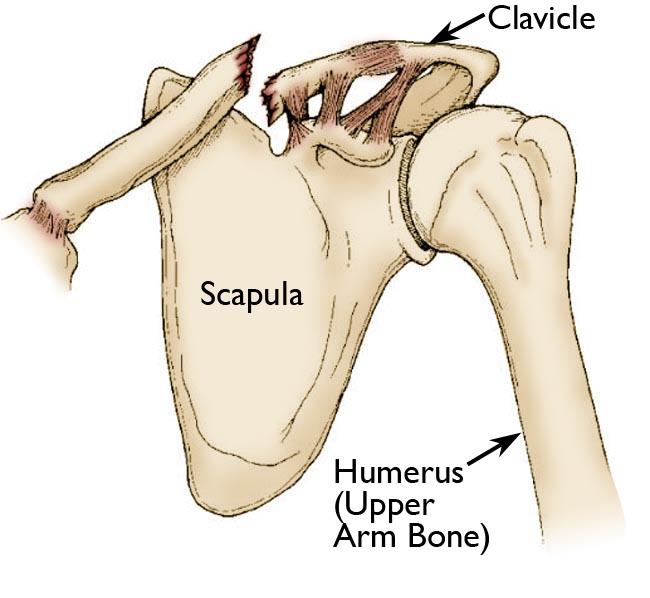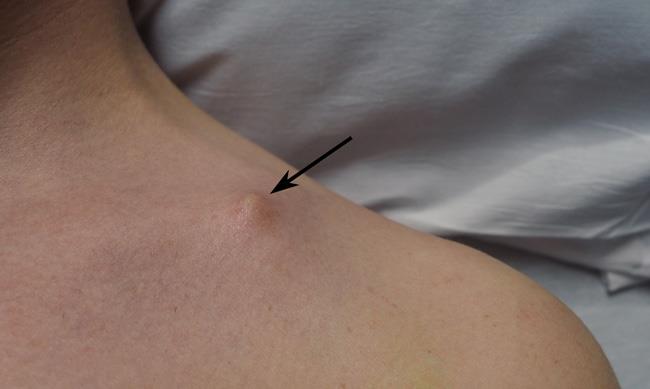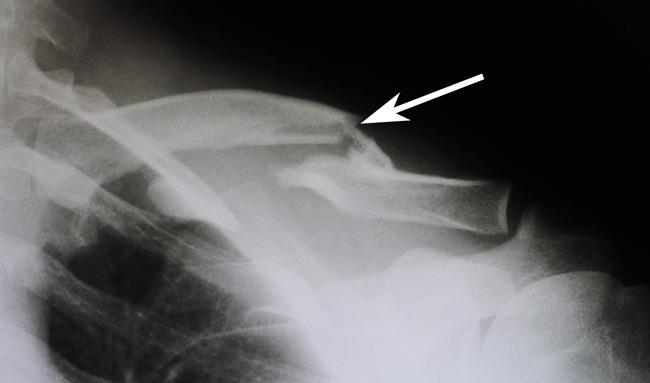Conditions Explained
Disclaimer:
This website is intended to assist with patient education and should not be used as a diagnostic, treatment or prescription service, forum or platform. Always consult your own healthcare practitioner for a more personalised and detailed opinion
Broken Collarbone
Also known as "Clavical Fracture."
We have selected the following expert medical opinion based on its clarity, reliability and accuracy. Credits: Sourced from the website OrthoInfo, contributed/updated by Dr Jason A. Lowe, peer-reviewed by Dr Stuart J. Fischer. Please refer to your own medical practitioner for a final perspective, assessment or evaluation.
What is a broken collarbone?
A broken collarbone is a break in the collarbone, one of the main bones in the shoulder. This type of fracture is fairly common—accounting for about 5 percent of all adult fractures. Most clavicle fractures occur when a fall onto the shoulder or an outstretched arm puts enough pressure on the bone that it snaps or breaks. A broken collarbone can be very painful and can make it hard to move your arm.
Most clavicle fractures can be treated by wearing a sling to keep the arm and shoulder from moving while the bone heals. With some clavicle fractures, however, the pieces of bone move far out of place when the injury occurs. For these more complicated fractures, surgery may be needed to realign the collarbone.
Anatomy
The clavicle is located between the ribcage (sternum) and the shoulder blade (scapula). It is the bone that connects the arm to the body.
The clavicle lies above several important nerves and blood vessels. However, these vital structures are rarely injured when a fracture occurs.
The clavicle is part of your shoulder and connects your arm to your ribcage:

Reproduced and adapted from JF Sarwak, ed: Essentials of Musculoskeletal Care, ed. 4. Rosemont, IL, American Academy of Orthopaedic Surgeons, 2010.
Description
Clavicle fractures are fairly common and occur in people of all ages. Most fractures occur in the middle portion, or shaft, of the bone. Occasionally, the bone will break where it attaches at the ribcage or shoulder blade.
Clavicle fractures vary. The bone can crack just slightly or break into many pieces (comminuted fracture). The broken pieces of bone may line up straight or may be far out of place (displaced fracture).
This illustration shows a clavicle fracture close to where the bone attaches to the scapula (shoulder blade).

Reproduced and adapted from Nuber GW, Bowen MK: Acromioclavicular joint injuries and distal clavicle fractures. J Am Acad Orthop Surg 1997; 5(1): 11-18.
Cause
Clavicle fractures are most often caused by a direct blow to the shoulder. This can happen during a fall onto the shoulder or a car collision. A fall onto an outstretched arm can also cause a clavicle fracture. In a baby, a clavicle fracture can occur during the passage through the birth canal.
Symptoms
A clavicle fracture can be very painful and may make it hard to move your arm.
Other signs and symptoms of a fracture may include:
- Sagging of the shoulder downward and forward
- Inability to lift the arm because of pain
- A grinding sensation when you try to raise the arm
- A deformity or "bump" over the break
- Bruising, swelling, and/or tenderness over the collarbone
Doctor Examination
Physical Examination
Your doctor will want to know how the injury occurred and will ask about your symptoms. He or she will then carefully examine your shoulder.
In a clavicle fracture, there is usually an obvious deformity, or "bump," at the fracture site. Gentle pressure over the break will bring about pain. Although it is rare for a bone fragment to break through the skin, it may push the skin into a "tent" formation.
Your doctor will also perform tests to ensure that no nerves or blood vessels were damaged when the fracture occurred.
In a clavicle fracture, the broken ends of the bone may cause tenting of the skin over the fracture site:

Imaging Studies
X-rays
X-rays provide images of dense structures, such as bone. Your doctor will order an x-ray to help pinpoint the location of the fracture and to learn more about the severity of the break.
He or she may also order x-rays of your entire shoulder to check for additional injuries. If other bones are broken, your doctor may order a computerized tomography (CT) scan to see the fractures in better detail.
X-ray shows a fracture in the middle of the clavicle. Note how far out of place (displaced) the broken ends of the bone are.

Treatment
Nonsurgical Treatment
If the broken ends of the bones have not significantly shifted out of place, you may not need surgery. Most broken collarbones can heal without surgery.
Nonsurgical treatment may include:
- Arm support: A simple arm sling is usually used for comfort immediately after the break and to keep your arm and shoulder in position while the injury heals.
- Medication: Pain medication, including acetaminophen, can help relieve pain as the fracture heals.
- Physical therapy: Although there will be some pain, it is important to maintain arm motion to prevent stiffness. Often, patients will begin doing exercises for elbow motion immediately after the injury.
After a clavicle fracture, it is common to lose some shoulder and arm strength. Once the bone begins to heal, your pain will decrease and your doctor may start gentle shoulder exercises. These exercises will help prevent stiffness and weakness. More strenuous exercises will be started gradually once the fracture is completely healed.
Follow-up care: You will need to see your doctor regularly until your fracture heals. During these visits, he or will take x-rays to make sure the bone is healing in a good position. After the bone has healed, you will be able to gradually return to your normal activities.
Complications: In some cases, a clavicle fracture can move out of place before it heals. It is important to follow up with your doctor as scheduled to make sure the bone stays in position.
If the fracture fragments do move out of place and the bones heal in that position, it is called a "malunion." Treatment for this is determined by how far out of place the bones are and how much this affects your arm movement.
A large bump over the fracture site may develop as the fracture heals. This usually gets smaller over time, but a small bump may remain permanently.
Surgical Treatment
If the broken ends of the bones have significantly shifted out of place, your doctor may recommend surgery.
Surgery typically involves putting the broken pieces of bone back into position and preventing them from moving out of place until they are healed. This can improve shoulder strength when you have recovered.
Open reduction and internal fixation
This is the procedure most often used to treat clavicle fractures. During the procedure, the bone fragments are first repositioned (reduced) into their normal alignment. The pieces of bone are then held in place with special metal hardware.
Common methods of internal fixation include:
- Plates and screws: After being repositioned into their normal alignment, the bone fragments are held in place with special screws and metal plates attached to the outer surface of the bone.
After surgery, you may notice a small patch of numb skin below the incision. This numbness will become less noticeable with time. Because the clavicle lies directly under the skin, you may be able to feel the plate through your skin.
Plates and screws are not routinely removed after the bone has healed, unless they are causing discomfort. Problems with the hardware are not common, but some patients find that seatbelts and backpacks can irritate the collarbone area. If this happens, the hardware can be removed after the fracture has healed.
(Left)X-ray shows a displaced clavicle fracture (arrow). (Right)The pieces of bone have been realigned and held in place with plates and screws.

- Pins or screws: Pins or screws can also be used to hold the fracture in good position after the bone ends have been put back in place. The incisions for pin or screw placement are usually smaller than those used for plates.
Pins or screws often irritate the skin where they have been inserted and are usually removed once the fracture has healed.
(Left) X-ray shows a severely displaced clavicle fracture (arrow). (Right) Here, a single screw has been used to repair the fracture.

Reproduced from Eichinger JK, Balog TP, Grassbaugh JA: Intramedullary fixation of clavicle fractures: anatomy, indications, advantages, and disadvantages. J Am Acad Orthop Surg 2016; 24(7): 455-464.
Pain management
After surgery, you will feel some pain.This is a natural part of the healing process. Many patients find that using ice and simple, non-prescription medications for pain relief are all that is needed to relieve pain.
If your pain is severe, your doctor may suggest a prescription-strength medication, such as an opioid, for a few days.
Be aware that although opioids help relieve pain after surgery, they are a narcotic and can be addictive. Opioid dependency and overdose has become a critical public health issue. For this reason, opioids are typically prescribed for a short period of time. It is important to use opioids only as directed by your doctor. As soon as your pain begins to improve, stop taking opioids.
Rehabilitation
Specific exercises will help restore movement and strengthen your shoulder. Your doctor may provide you with a home therapy plan or suggest that you work with a physical therapist.
Therapy programs typically start with gentle motion exercises. Your doctor will gradually add strengthening exercises to your program as your fracture heals.
Although it is a slow process, following your physical therapy plan is an important factor in returning to all the activities you enjoy.
Complications
There are risks associated with any type of surgery.
These include:
- Infection
- Bleeding
- Problems with wound healing
- Pain
- Blood clots
- Damage to blood vessels or nerves
- Reaction to anesthesia
Risks that are specific to surgery for clavicle fractures include:
- Difficulty with bone healing
- Lung injury
- Hardware irritation
Patients who smoke or use tobacco products, have diabetes, or are elderly are at a higher risk for complications both during and after surgery. They are also more likely to have problems with wound and bone healing.
Before your surgery, your doctor will discuss each of the risks with you and will take specific measures to avoid complications.
Outcome
Whether your treatment involves surgery or not, it can take several months for your collarbone to heal. Healing may take longer in diabetics or in people who smoke or use tobacco products.
Most people return to their regular activities within 3 months of their injury. Your doctor will tell you when your injury is stable enough to do so. Returning to regular activities or lifting with your arm before your doctor advises may cause the fracture fragments to move or the hardware to break. This may require you to start your treatment from the beginning.
Once your fracture has completely healed, you can safely return to sports activities.
Questions to Ask Your Doctor
If you experience a clavicle fracture, here are some questions you may wish to ask your doctor:
- When can I start using my arm?
- When can I return to work?
- Do I have any specific risks for not doing well?
- If I have to have surgery, what are the risks and benefits and how long will I be in the hospital?
- What are the risks and benefits of nonsurgical treatment?
_______________________________________________________________________________________________________________________
Are you a healthcare practitioner who enjoys patient education, interaction and communication?
If so, we invite you to criticise, contribute to or help improve our content. We find that many practicing doctors who regularly communicate with patients develop novel and often highly effective ways to convey complex medical information in a simplified, accurate and compassionate manner.
MedSquirrel is a shared knowledge, collective intelligence digital platform developed to share medical expertise between doctors and patients. We support collaboration, as opposed to competition, between all members of the healthcare profession and are striving towards the provision of peer reviewed, accurate and simplified medical information to patients. Please share your unique communication style, experience and insights with a wider audience of patients, as well as your colleagues, by contributing to our digital platform.
Your contribution will be credited to you and your name, practice and field of interest will be made visible to the world. (Contact us via the orange feed-back button on the right).